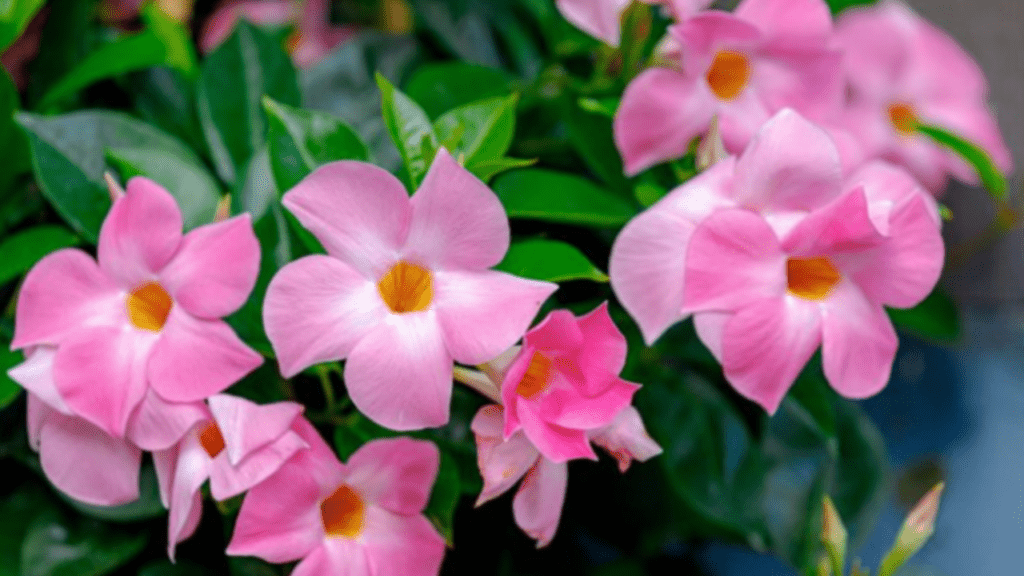
Mandevilla Care Guide: How to Grow and Maintain Vibrant Vines
Mandevilla plants are a beautiful addition to any garden or outdoor space, but they do require specific care in order to thrive. In this comprehensive guide, we will provide you with step-by-step instructions on how to grow and maintain vibrant mandevilla vines. Whether you’re a seasoned gardener or a beginner, this guide will give you the knowledge and confidence to keep your mandevilla plants healthy and flourishing. From watering and sunlight requirements to pruning and pest control, we’ve got you covered with all the essential tips and tricks for successful mandevilla care. So let’s dive in and learn how to grow and maintain vibrant vines!
Table of Contents
ToggleUnderstanding Mandevilla Plants
Overview of Mandevilla species
Common varieties and their characteristics
Mandevilla plants are a beautiful addition to any garden or outdoor space, but they do require specific care in order to thrive. In this comprehensive guide, we will provide you with step-by-step instructions on how to grow and maintain vibrant mandevilla vines. Whether you’re a seasoned gardener or a beginner, this guide will give you the knowledge and confidence to keep your mandevilla plants healthy and flourishing. From watering and sunlight requirements to pruning and pest control, we’ve got you covered with all the essential tips and tricks for successful mandevilla care. So let’s dive in and learn how to grow and maintain vibrant vines! When it comes to understanding Mandevilla plants, it’s important to know that these vining plants are native to Central and South America. They belong to the Apocynaceae family and are known for their beautiful flowers and glossy leaves. Mandevilla plants are typically grown as vines, and they can produce stunning blooms in various colors, including pink, red, white, and yellow. These plants thrive in warm and sunny climates and are often used as ornamental plants in gardens and landscapes. The most common varieties of Mandevilla include Mandevilla sanderi, Mandevilla boliviensis, and Mandevilla splendens. Each variety has its own unique characteristics, such as flower color, growth habit, and hardiness. Understanding the differences between these varieties can help you choose the right mandevilla plant for your garden and provide the best care for it.
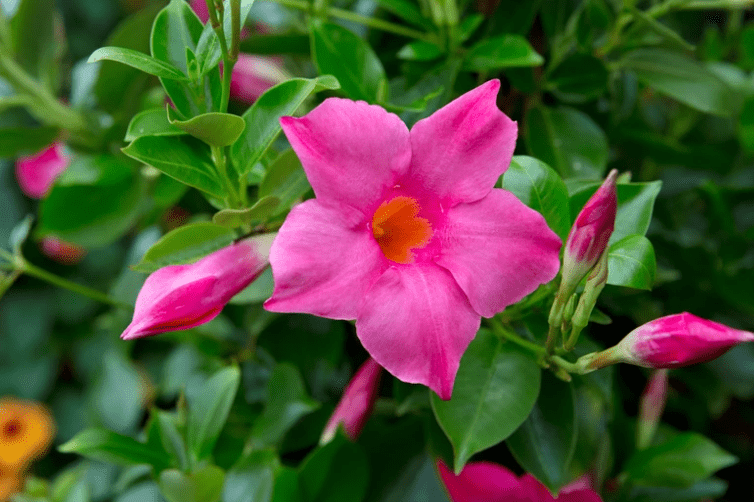
Ideal growing conditions
Climate
Mandevilla plants thrive in warm and sunny climates. They prefer temperatures between 60-80 degrees Fahrenheit and need at least 6 hours of direct sunlight each day. They do well in USDA hardiness zones 9-11 and can be grown outdoors year-round in these zones. If you live in a cooler climate, you can still grow mandevilla plants, but you may need to bring them indoors during the winter months or treat them as annual plants. It’s important to provide proper care and protection for mandevilla plants to ensure they thrive in their ideal growing conditions.
Soil type
Soil type is also an important factor to consider when growing mandevilla plants. They prefer well-draining, fertile soil with a slightly acidic pH level. A good potting mix for container-grown mandevilla plants should include peat moss, perlite, and compost to provide the ideal growing environment. If planting directly in the ground, make sure the soil is well-draining and amend it with organic matter to improve fertility. Avoid heavy clay soils, as they can cause root rot and other issues for mandevilla plants. By providing the right soil type, you can ensure that your mandevilla plants have the best growing conditions to thrive and produce beautiful flowers.
Light requirements
Light requirements are an important aspect of caring for mandevilla plants. These plants thrive in full sun, so it’s essential to place them in an area where they can receive at least six hours of direct sunlight each day. If you’re growing mandevilla indoors, place them in a sunny window or under grow lights to ensure they get the light they need to thrive. In addition to full sun, mandevilla plants also benefit from some afternoon shade, especially in hot climates. Providing the right amount of light will ensure that your mandevilla plants grow and bloom to their full potential. Overall, taking into account the light and soil requirements of mandevilla plants will help you provide the best possible care for these beautiful flowering plants.
Planting Mandevilla
Choosing the right location
Is crucial for the health and growth of your mandevilla plants. These plants require well-draining soil, so it’s important to choose a location with soil that is rich in organic matter and has good drainage. Additionally, mandevilla plants thrive in full sun, so it’s best to plant them in an area where they can receive at least six hours of direct sunlight each day. If you’re growing mandevilla indoors, be sure to place them in a sunny window or under grow lights to provide the light they need to thrive. In hot climates, providing some afternoon shade can also benefit the plants. By considering the soil type and light requirements, you can ensure that your mandevilla plants have the best growing conditions to thrive and produce beautiful flowers.
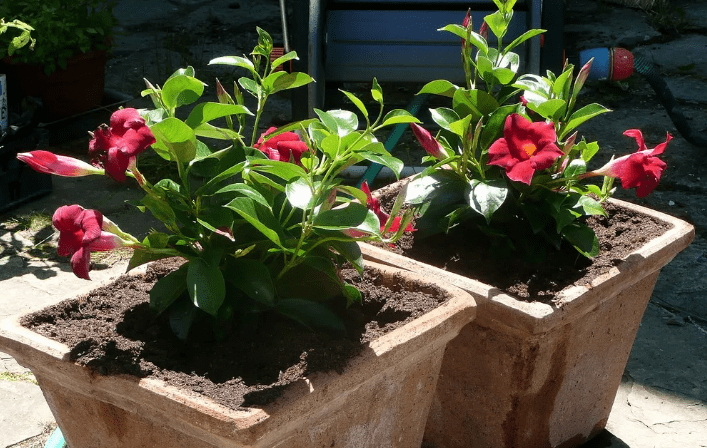
Soil preparation
Is an essential step in ensuring the successful growth of mandevilla care plants. Before planting, it’s important to prepare the soil to provide the best growing conditions for these beautiful flowering plants. Mandevilla plants require well-draining soil with a rich organic matter content. To prepare the soil, you can add compost or organic matter to improve its structure and fertility. This will ensure that the soil provides the necessary nutrients and moisture retention for the plants to thrive. Additionally, testing the pH of the soil and making any necessary adjustments can also contribute to the health and growth of mandevilla plants. By taking the time to properly prepare the soil, you can create an optimal growing environment for your mandevilla care, allowing them to flourish and produce stunning blooms.
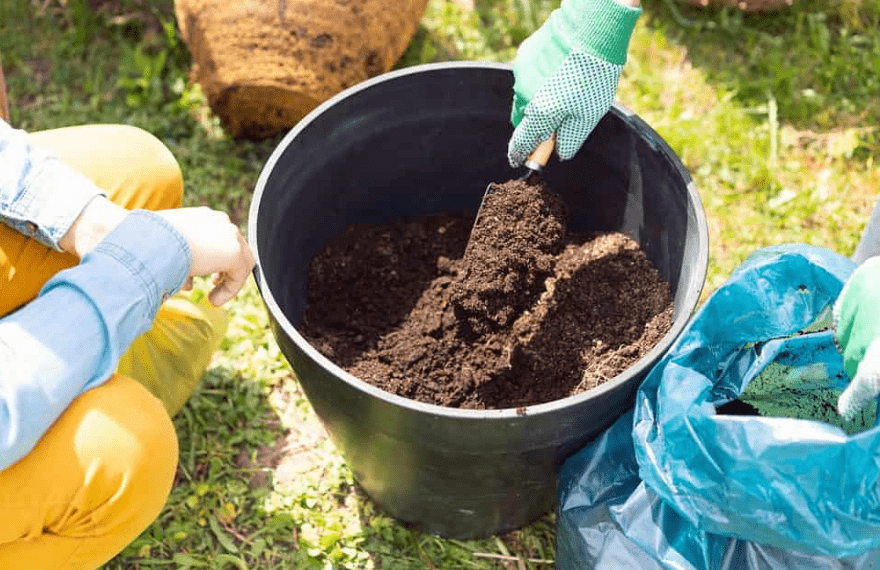
Planting techniques
are important to consider when it comes to planting mandevilla plants. When planting mandevilla, it’s important to dig a hole that is twice as wide and deep as the root ball of the plant. This will provide enough space for the roots to spread and grow. It’s also important to ensure that the plant is planted at the same level as it was in the pot, as planting too deep or too shallow can affect the plant’s health and growth.
Once the hole is prepared, gently remove the plant from its pot and place it in the hole. Fill the hole with soil and gently firm it around the plant to remove any air pockets. Water the plant thoroughly after planting to help it settle into its new environment.
In addition to proper planting techniques, it’s important to consider the location and sun exposure for mandevilla plants. These plants thrive in full sun or partial shade, so it’s important to choose a location that provides the right amount of sunlight for optimal growth.
By following these planting techniques, you can ensure that your mandevilla plants have the best chance of thriving and producing beautiful blooms. Proper soil preparation and planting techniques are essential for the successful growth of mandevilla plants.
Watering and Fertilizing Mandevilla
Watering needs
Mandevilla plants require regular watering, especially during the growing season. It’s important to keep the soil consistently moist, but not waterlogged. Water the plants deeply, allowing the water to penetrate the soil and reach the roots. During the hotter months, you may need to water the plants more frequently to prevent the soil from drying out.
Fertilizing needs: Mandevilla plants benefit from regular fertilization to support healthy growth and blooming. Use a balanced, water-soluble fertilizer formulated for flowering plants. Apply the fertilizer according to the instructions on the label, usually every two to four weeks during the growing season. Avoid over-fertilizing, as this can lead to excessive foliage growth at the expense of flowers.
By meeting the watering and fertilizing needs of mandevilla plants, you can promote vigorous growth, abundant blooms, and overall plant health. Remember to monitor the soil moisture and adjust your watering schedule as needed, and provide regular fertilization to support the plant’s nutritional needs. With proper care, your mandevilla plants will thrive and bring beauty to your garden.
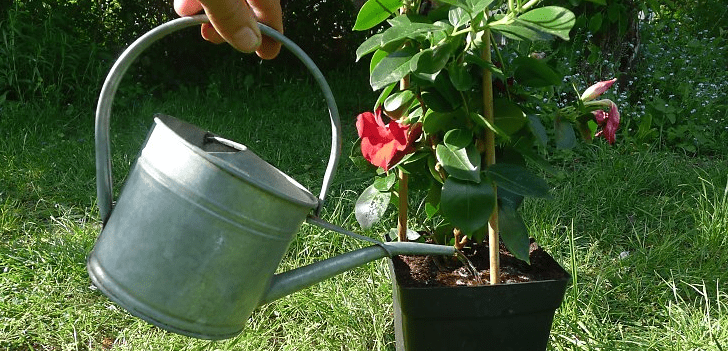
Fertilizing schedule
In order to keep your Mandevilla plants healthy and thriving, it is important to follow a regular fertilizing schedule. These plants benefit from regular fertilization to support healthy growth and blooming. It is best to use a balanced, water-soluble fertilizer formulated for flowering plants. Be sure to apply the fertilizer according to the instructions on the label, which typically means every two to four weeks during the growing season. It is important to avoid over-fertilizing, as this can lead to excessive foliage growth at the expense of flowers. By meeting the watering and fertilizing needs of mandevilla plants, you can promote vigorous growth, abundant blooms, and overall plant health. Remember to monitor the soil moisture and adjust your watering schedule as needed, and provide regular fertilization to support the plant’s nutritional needs. With proper care, your mandevilla plants will thrive and bring beauty to your garden.
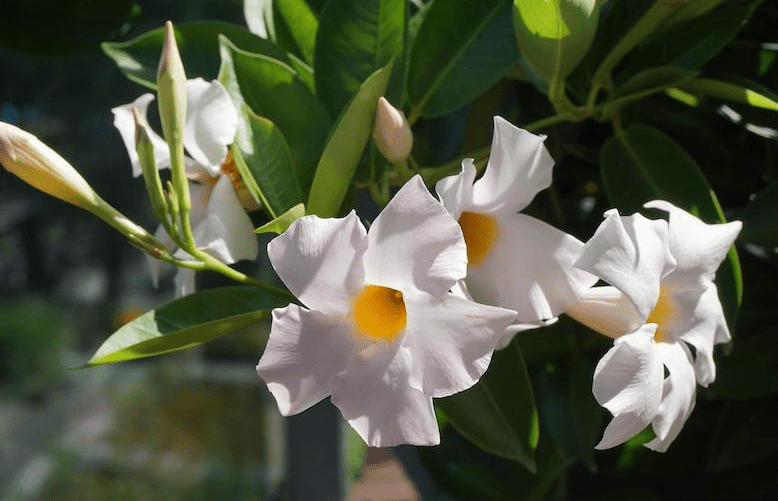
Pruning and Training Mandevilla
Importance of pruning for healthy growth
When and how to prune
Pruning is important for the healthy growth of mandevilla plants. It helps to remove dead or overgrown branches, encourages new growth, and promotes a more compact and bushy shape. It is best to prune mandevilla plants in the early spring before new growth begins. You can use pruning shears to remove any dead or damaged growth, as well as to shape the plant as desired. Be sure to make clean cuts just above a leaf node to promote new growth. Additionally, you can train the vines of mandevilla plants to grow on a trellis or supporting structure to create a beautiful and lush display. Regular pruning and training will help to keep your mandevilla plants looking healthy and vibrant.
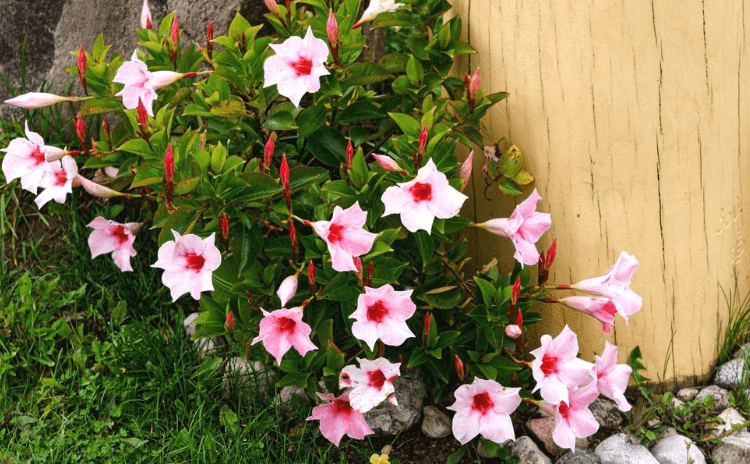
Tools needed for pruning
Pruning mandevilla plants is essential for their healthy growth and appearance. To properly prune and train your mandevilla, you will need a few key tools. These include pruning shears for cutting back dead or overgrown branches, a pair of sharp scissors for more delicate pruning, and gardening gloves to protect your hands from thorns and rough plant material. Additionally, a trellis or supporting structure will be useful for training the vines to grow in a desired direction. Having the right tools on hand will make the pruning process much easier and more effective, resulting in beautifully maintained mandevilla plants.
Training Mandevilla vines
Using trellises and supports
Using trellises and supports is a great way to create a beautiful and lush display with your mandevilla plants. By training the vines to grow on a trellis or supporting structure, you can create a stunning and vibrant garden feature. Regular pruning and training are important to keep your mandevilla plants looking healthy and beautiful. To properly prune and train your mandevilla, you will need a few key tools such as pruning shears, sharp scissors, and gardening gloves. These tools will make the pruning process much easier and more effective. Additionally, having a trellis or supporting structure will help you to train the vines to grow in a desired direction, creating a stunning visual effect in your garden. With the right tools and techniques, you can create a beautiful and lush display of mandevilla plants in your garden.
Techniques for guiding growth
Training Mandevilla vines is an important aspect of maintaining a healthy and vibrant garden. Using trellises and supports is a great way to create a beautiful and lush display with your mandevilla plants. By training the vines to grow on a trellis or supporting structure, you can create a stunning and vibrant garden feature. Regular pruning and training are important to keep your mandevilla plants looking healthy and beautiful. To properly prune and train your mandevilla, you will need a few key tools such as pruning shears, sharp scissors, and gardening gloves. These tools will make the pruning process much easier and more effective. Additionally, having a trellis or supporting structure will help you to train the vines to grow in a desired direction, creating a stunning visual effect in your garden. With the right tools and techniques, you can create a beautiful and lush display of mandevilla plants in your garden.
Pest and Disease Management
Common pests affecting Mandevilla
Identification and control methods
Mandevilla plants can be prone to certain pests and diseases, so it’s important to be proactive in managing these issues. Common pests that can affect mandevilla plants include whiteflies, aphids, and spider mites. To identify these pests, look for small insects on the leaves and stems of the plant, as well as any signs of damage such as yellowing or wilting leaves. To control these pests, you can use insecticidal soap or neem oil to safely and effectively eliminate them from your plants.
In addition to pests, mandevilla plants can also be susceptible to diseases such as powdery mildew and leaf spot. These diseases can cause discoloration and damage to the leaves and stems of the plant. To control these diseases, it’s important to remove any affected plant material and apply a fungicidal spray to prevent further spread.
Overall, regular monitoring of your mandevilla plants, along with proper pruning and maintenance, can help to prevent and manage pest and disease issues. By staying proactive and using appropriate control methods, you can keep your mandevilla plants healthy and thriving.
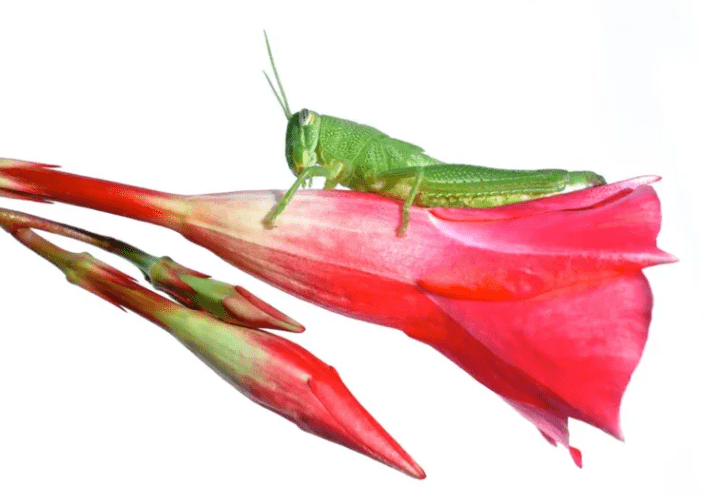
Diseases and how to prevent them
Symptoms and treatments
When it comes to identifying pests on your plants, look for small insects on the leaves and stems, as well as signs of damage like yellowing or wilting leaves. To control these pests, you can use insecticidal soap or neem oil to safely and effectively eliminate them from your plants. In addition to pests, mandevilla plants can also be susceptible to diseases such as powdery mildew and leaf spot. These diseases can cause discoloration and damage to the leaves and stems of the plant. To control these diseases, it’s important to remove any affected plant material and apply a fungicidal spray to prevent further spread. Regular monitoring of your mandevilla plants, along with proper pruning and maintenance, can help prevent and manage pest and disease issues. Staying proactive and using appropriate control methods will keep your mandevilla plants healthy and thriving.
Organic and chemical control options
Organic and chemical control options are available for managing pests and diseases on your plants. When it comes to preventing diseases, it’s important to regularly monitor your plants for any signs of discoloration or damage. Common symptoms of diseases in plants include yellowing or wilting leaves, as well as the presence of powdery mildew or leaf spot. To treat these diseases, you can use organic fungicidal sprays or chemical control options to effectively eliminate the disease and prevent further spread. It’s important to remove any affected plant material to stop the spread of disease and keep your plants healthy. In terms of pest control, look for small insects on the leaves and stems of your plants, as well as any signs of damage. Insecticidal soap or neem oil are effective and safe options for controlling pests on your plants. It’s important to choose the right control method based on the specific pest or disease affecting your plants. By staying proactive and using appropriate control methods, you can effectively manage pests and diseases and keep your plants healthy and thriving.
Seasonal Care Tips
Spring and summer care
Spring and summer care are crucial for keeping your plants healthy and thriving. During these seasons, it’s important to monitor your plants for any signs of diseases and pests. Common symptoms of diseases in plants include yellowing or wilting leaves, as well as the presence of powdery mildew or leaf spot. To treat these diseases, you can use organic fungicidal sprays or chemical control options to effectively eliminate the disease and prevent further spread. It’s important to remove any affected plant material to stop the spread of disease and keep your plants healthy.
In terms of pest control, look for small insects on the leaves and stems of your plants, as well as any signs of damage. Insecticidal soap or neem oil are effective and safe options for controlling pests on your plants. It’s important to choose the right control method based on the specific pest or disease affecting your plants. By staying proactive and using appropriate control methods, you can effectively manage pests and diseases and keep your plants healthy and thriving. So, be on the lookout for any signs of disease or pests and take the necessary steps to protect your plants during the spring and summer months.
Fall and winter care
For your plants is essential to ensure they stay healthy and thrive throughout the colder months. During this time, plants are more susceptible to diseases and pests, so it’s important to be proactive in caring for them. To treat these diseases, you can use organic fungicidal sprays or chemical control options to effectively eliminate the disease and prevent further spread. It’s important to remove any affected plant material to stop the spread of disease and keep your plants healthy.
In terms of pest control, look for small insects on the leaves and stems of your plants, as well as any signs of damage. Insecticidal soap or neem oil are effective and safe options for controlling pests on your plants. It’s important to choose the right control method based on the specific pest or disease affecting your plants. By staying proactive and using appropriate control methods, you can effectively manage pests and diseases and keep your plants healthy and thriving.
So, be on the lookout for any signs of disease or pests and take the necessary steps to protect your plants during the fall and winter months. With the right care and attention, you can ensure that your plants survive the colder months and continue to flourish when spring arrives.
Troubleshooting Common Problems
Yellowing leaves
Yellowing leaves can be a sign of a few different issues with your plants. It could be from overwatering, nutrient deficiencies, or even pests. It’s important to remove any affected plant material to stop the spread of disease and keep your plants healthy. In terms of pest control, look for small insects on the leaves and stems of your plants, as well as any signs of damage. Insecticidal soap or neem oil are effective and safe options for controlling pests on your plants. It’s important to choose the right control method based on the specific pest or disease affecting your plants. By staying proactive and using appropriate control methods, you can effectively manage pests and diseases and keep your plants healthy and thriving. So, be on the lookout for any signs of disease or pests and take the necessary steps to protect your plants during the fall and winter months. With the right care and attention, you can ensure that your plants survive the colder months and continue to flourish when spring arrives.
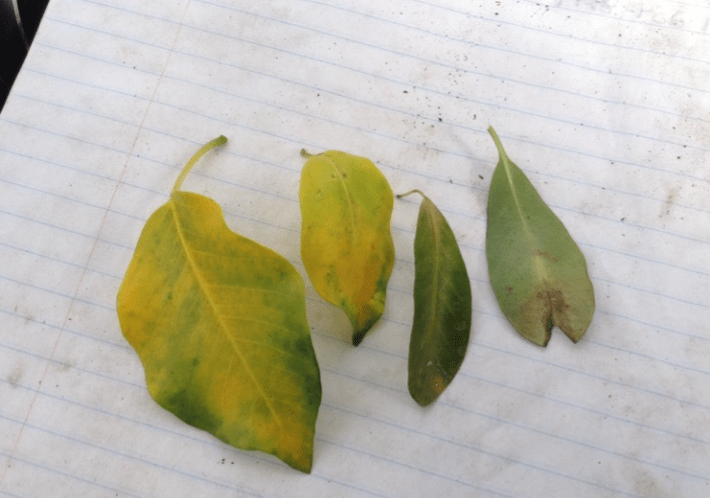
Lack of blooms
Lack of blooms can be a sign of several different issues with your plants. It’s important to properly diagnose the problem in order to take the appropriate action to encourage blooming. One common issue is lack of sunlight, so make sure your plants are getting enough light to support blooming. Another issue could be nutrient deficiency, so consider using a fertilizer specifically designed to encourage flowering. Additionally, make sure you are not overwatering or underwatering your plants, as this can also impact their ability to bloom. If you notice any signs of disease or pests on your plants, it’s important to address these issues as they can also affect blooming. By taking the necessary steps to address these issues, you can help your plants to produce beautiful blooms and thrive.
Dealing with stressed plants
Can be a challenging task, but with the right care and attention, you can ensure that your plants survive the colder months and continue to flourish when spring arrives. One common sign of stress in plants is the lack of blooms. This can be a sign of several different issues with your plants, and it’s important to properly diagnose the problem in order to take the appropriate action to encourage blooming. One common issue is lack of sunlight, so make sure your plants are getting enough light to support blooming. Another issue could be nutrient deficiency, so consider using a fertilizer specifically designed to encourage flowering. Additionally, make sure you are not overwatering or underwatering your plants, as this can also impact their ability to bloom. If you notice any signs of disease or pests on your plants, it’s important to address these issues as they can also affect blooming. By taking the necessary steps to address these issues, you can help your plants to produce beautiful blooms and thrive. Remember to provide proper care and attention to your plants, and they will reward you with their beauty and resilience.
Propagating Mandevilla
Propagating Mandevilla can be a rewarding and enjoyable process. One common method of propagation is through stem cuttings. To do this, take a 6-inch cutting from a healthy Mandevilla plant, making sure to include at least one node. Remove the lower leaves and dip the cut end in rooting hormone before planting it in a well-draining soil mix. Keep the soil consistently moist and provide the cutting with bright, indirect light. With time and care, the cutting should develop roots and begin to grow into a new plant. Another method of propagation is through layering, where a portion of a stem is buried in soil while still attached to the parent plant. Once roots develop, the new plant can be separated and potted on its own. Regardless of the method you choose, it’s important to provide the right conditions for the cutting or new plant to thrive. With proper care and attention, you can successfully propagate Mandevilla and expand your garden with beautiful new plants.
In conclusion, caring for mandevilla plants is relatively simple as long as you provide them with the right conditions. By following the tips and instructions provided in this guide, you can ensure that your mandevilla vines will thrive and add beauty to your garden or outdoor space. Remember to water them regularly, provide them with ample sunlight, and prune them as needed to maintain their health and vibrancy. With proper care, you can enjoy beautiful mandevilla vines for years to come.
Frequently asked questions And Answer
Mandevilla plants thrive in full sunlight, so it’s best to place them in a location where they can receive at least 6-8 hours of direct sunlight each day.
Mandevilla plants prefer well-draining, rich soil. A mixture of potting soil and perlite or sand can provide the ideal growing medium for these plants.
It’s important to water Mandevilla plants regularly, especially during the growing season. Water the plant when the top inch of soil feels dry, and be sure to water deeply to ensure that the roots receive adequate moisture.
Yes, Mandevilla plants benefit from regular fertilization during the growing season. Use a balanced, water-soluble fertilizer every 2-4 weeks to promote healthy growth and vibrant flowers.
Mandevilla plants are vining plants and will benefit from a trellis or support structure to climb and grow. You can gently guide the vines as they grow and secure them to the support to encourage upward growth.
Pruning Mandevilla plants is essential for maintaining shape and promoting new growth. It’s best to prune in early spring before new growth begins, cutting back any dead or overgrown vines to encourage healthy, bushy growth.
Yes, Mandevilla plants can be grown indoors as long as they receive adequate sunlight and proper care. Be sure to provide a sunny window or use grow lights to ensure that the plant receives enough light.
Keep an eye out for common pests such as aphids, spider mites, or whiteflies, and treat with insecticidal soap or neem oil if necessary. Additionally, proper air circulation and avoiding overwatering can help prevent disease issues such as powdery mildew or root rot.
